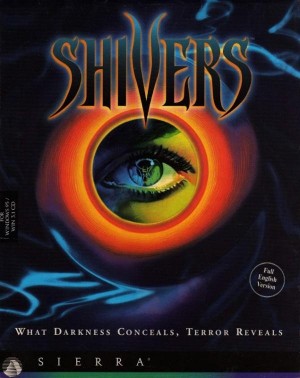Review for Shivers
In 1995, when adventure games were accepted by the average gamer far better than they are today, Sierra On-Line released a game borrowing elements from “Myst” and “The 7th Guest.” This game was “Shivers.”
“Welcome to Professor Windlenot’s Museum of the Strange and Unusual”
In "Shivers" you play a teenager who has accepted a challenge to spend a night inside the Museum of the Strange and Unusual on the top of Mt. Pleasant. Built by an eccentric archeologist named Professor Windlenot, the mysterious museum was never opened to the public. Since two teenagers disappeared fifteen years ago, rumors have circulated at the school where the Professor taught just before he started building his museum. According to rumors, the Professor went insane and is responsible for the deaths. Supposedly he hid the two bodies in the basement of the museum, which would explain why the police never found them. Are the rumors true, or are they just urban legends?
As soon as your friends lock you up behind the gate of the museum, you know there is something odd about this place. Looking behind you, you notice the museum high above with stairs leading upward, but you will quickly find that the entrance is somewhere else other than at the top of these stairs.
“What Darkness Conceals, Terror Reveals”
"Shivers" is made up of two parts. In the first, you will have to find the hidden entrance to the museum while in the second, you will be free to explore what the museum reveals. To locate the hidden passage, you must solve two puzzles located on the property surrounding the museum. The linearity in the adventure fortunately stops as soon as you enter the museum, and the gameplay could be compared to Virgin Interactive’s "The 7th Guest.” You will explore the numerous rooms, solve puzzles and learn what really happened in the museum and to its eccentric owner.
If the exploration and puzzles can be compared to "The 7th Guest", then the way you move about the game is directly inspired by "Myst." There are no animations when you navigate the museum; that is, you go from static picture to static picture. The main advantage of this is that moving from one spot to the next is done quite quickly. Movement in the game is done via the tried and true point-and-click formula.
The attention brought to the graphics was wonderful, at the time, with a plethora of details that make the rooms stunningly realistic. Even today the graphics hold up quite nicely, although it is obvious that this is an old game. The museum is divided into several departments, each related to legendary myths, such as the lost city of Atlantis, the werewolf, life after death, etc. Each department is completely different in size and form, with many artifacts and unusual tidbits of information. The puzzles you discover throughout the Museum will reveal secret passages, and even locations where you might discover important clues that could help you to solve puzzles in other rooms.
“If you die in the museum tonight, I’ll make sure she gives the eulogy at your funeral”
Finding objects and solving puzzles in “Shivers” is not always easy. Your goal is to capture the evil spirits, or Ixupi, that haunt the museum. Each Ixupi has its own corresponding pot, complete with a lid. If you attempt to capture a spirit with the incorrect pot and lid combination, you risk loosing some of your life essence, which is symbolized by a green strip running along the bottom of the screen. Lose all of your life essence, and you die. The Ixupi represent elements such as water and ash, which should give you a strong indication as to where you can expect to find them. Be careful not to click blindly through the game if you wish to survive. If you are fortunate enough to capture an Ixupi, you will regain a portion of your life essence. These captured spirits must then be taken back to their original resting place: the exhibit from which they escaped.
If you die (or start a new game), the location of some items and puzzles will change, making one game different from another. Although it is an interesting feature, I can't imagine myself playing "Shivers" many times over. Not that the game is boring, but changing the locations of the Ixupi and items doesn’t really entice me to play a second time (I should mention, though, that I did indeed play the game again for the purpose of this review. I wasn’t going to base my article on five year old memories!) Unfortunately, the conclusion of the game is always the same, ending with the capture of a particular Ixupi.
“Get out…get out…They are evil!”
Although the box claims the contrary, the sound effects and soundtrack of "Shivers" won't succeed in frightening you. However, it goes nicely with the creepy ambiance that surrounds the entire museum and contributes in giving the game an air of horror. I have heard others complain that some of the music is unfitting for the location in which it is played. Although I agree with this in some ways, I actually thought the mix of different musical styles really spiced up the audible experience.
The beginning of "Shivers" was a little too slow for my tastes, but after entering the museum I quite enjoyed it. I appreciated the splendid graphics (for their time, mind you), the good quality sound effects and the variety of puzzles. There is only one element of the game that I didn't like: the inventory. It can only contain one item at a time, regardless of what it is. This forces you to remember the location of objects you will use later in your adventure. Problems aside, Shivers is a game that's worth a quick look through your local computer store's bargain bin.




























